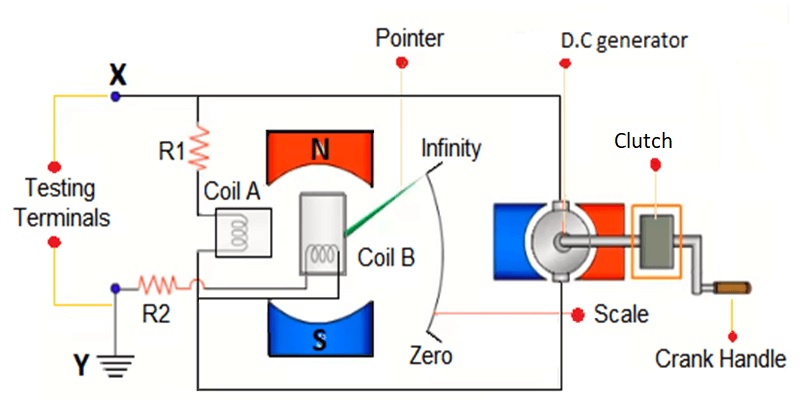Experiment No.: 4
Experiment Name:
Use Megger for measurement of insulation resistance
Objective:
To use Megger for measurement of insulation resistance of a 1100 V grade PVC cable
Theory:
A megger is used to measure insulation resistance and it is powered by a hand driven inbuilt DC generator or battery of a higher voltage range, it is called Megohmmeter. The device enable us to measure electrical leakage in wire, results are very reliable as we shall be passing electric current through device while we are testing. The equipment basically uses for verifying the electrical insulation level of any device such as motors, cables, generators, windings, etc. This is a very popular test being carried out since very long back. Not necessary it shows us exact area of electrical puncture but shows the amount of leakage current and level of moisture within electrical equipment/winding/system.
Circuit Diagram of Megger:

Connection for measuring insulation resistance:

Construction:
Megger is a DC generator. It consists of three terminals
- Line terminal,
- Guard terminal,
- and the earth terminal.
In the above circuit, the guard is connected on top of an insulator, the line terminal is connected to the conductor, which is to be tested, and the earth pin is grounded.
Higher Resistance = Higher Insulation = No current flow.
Procedure:
- Connect the circuit as per the diagram shown above.
- The handle of the megger is rotated at about 160 rpm by hand thus the megger will generate about 500 V to 1000 V DC.
- The current flows through cable, the resistance in scale is noted which ranges between 35 to 100 Mega Ohms.
- Note to maintain this contact for 30 to 60 seconds.
- Acceptable IR for electrical cable = 1 Mega Ohm for 1000 V.
Observation:
| Tested for | Insulation Resistance |
| 60 sec | 50 Mega Ohm |
Observation Table:
| Sl. No. | Name of the Apparatus | Specification | Quantity | Maker’s Name |
| 1. | Insulation Tester | Analog, 0-200-∞ MOhm, 500 V, Hand Driven | 1 | CIE |
| 2. | Cable | 2.5 sq. mm, Cu conductor, PVC insulated | 1 coil | Maru |
Remarks: If the range shown is between 35 to 100 Mega Ohm’s, it means it’s a good insulator.
